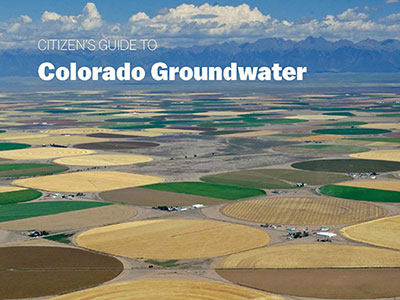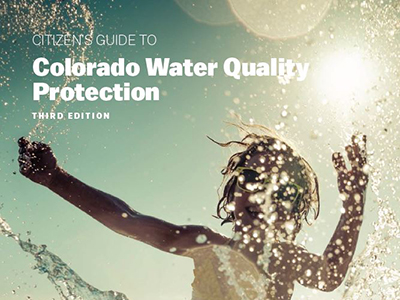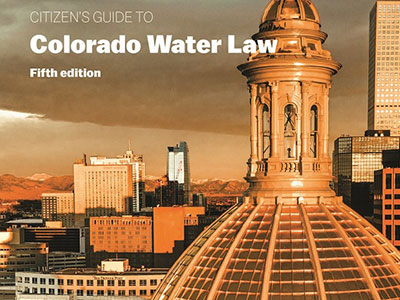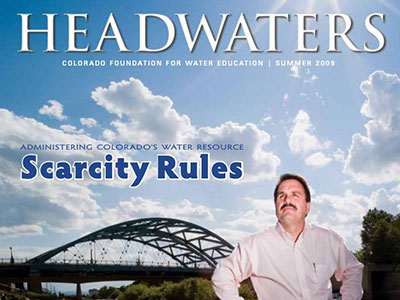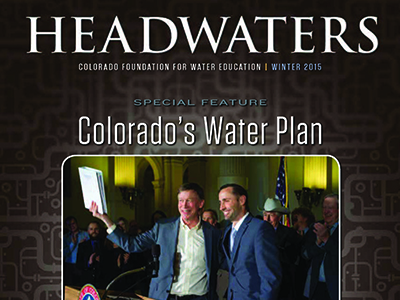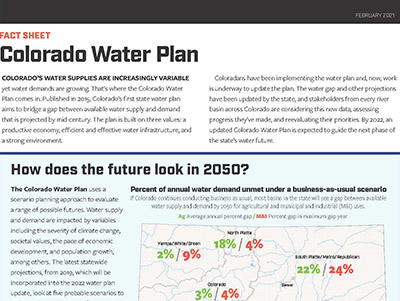State & Regional Water Agencies
Colorado Division of Water Resources
Housed within the Colorado Department of Natural Resources, the Colorado Division of Water Resources, which includes the State Engineer, division engineers and water commissioners, has the authority to administer all surface water and Denver Basin, tributary and nontributary groundwater in the state of Colorado.
The 1969 Water Right Determination and Administration Act, section 37-92-501(2)(e), states that rules of the State Engineer “shall have as their objective the optimum use of water consistent with preservation of the priority system of water rights.” Although Colorado statutes and court decisions appear to refer interchangeably to maximum utilization and optimum use, the Colorado Supreme Court has ruled that Colorado water law does not require squeezing out every drop of water available. Rather, the law favors optimum use, which entails “proper regard for all significant factors, including environmental and economic concerns be taken into account.”
Throughout Colorado, the holders of decreed water rights depend on the State Engineer to shut down or reduce junior decreed uses, in addition to undecreed uses, to satisfy the demand of decreed senior uses. There is a division engineer’s office located in each of the seven water divisions in Colorado, where water commissioners go into the field and distribute the waters of the state in priority and according to the decreed terms.
The State Engineer also administers nontributary and Denver Basin groundwater under its well permit and rulemaking authority. The Colorado Ground Water Commission and local groundwater management districts administer groundwater in the designated groundwater basins.
The State Engineer has authority to adopt rules for administration of surface, tributary and nontributary groundwater rights in each of Colorado’s river basins; authority to adopt rules to meet interstate compact requirements; and authority to adopt rules for administration of nontributary groundwater produced in oil and gas development. Proposed rules are subject to water court review and approval.
Colorado Water Conservation Board
The Colorado Water Conservation Board (CWCB) is a statewide agency created by the Colorado General Assembly in 1937. Also housed within the Department of Natural Resources, the CWCB’s purpose is to aid in the protection and development of the state’s waters.
The CWCB has 15 members. The governor appoints eight members from each of the state’s major river basins and one member from the City and County of Denver. All appointees are subject to Senate confirmation and serve three-year terms. Other members of the Board appointed by virtue of office or position include the executive director of the Department of Natural Resources, Attorney General, State Engineer, Commissioner of Agriculture and director of the Colorado Water Conservation Board. Only the executive director of the Department of Natural Resources has a vote among those on the Board serving by virtue of their office or position; all others serve as ex-officio members.
The CWCB is responsible for flood control and protection, development of statewide water policy, and identifying and recommending water development projects, among other duties. It also makes loans and grants available for the construction of water projects. The CWCB also has certain interstate compact responsibilities on the Colorado River and Arkansas River and assists the Colorado Division of Water Resources and State Engineer on the other interstate compacts.
In 1973, the Colorado General Assembly recognized the “need to correlate the activities of mankind with some reasonable preservation of the natural environment.” It created the Instream Flow and Natural Lake Level Program as part of the CWCB’s responsibilities. Instream flows and natural lake levels, according to legislative definition, are the flows or lake levels needed to preserve or improve the natural environment to a reasonable degree. In addition, there are three endangered species recovery programs (Upper Colorado, San Juan and Platte) for which the Colorado Water Conservation Board takes lead responsibility.
In 2023, the CWCB finalized an update to the Colorado Water Plan. The state’s first-ever water plan was published in 2015 and CWCB takes lead responsibility for updating and implementing it.
Colorado Department of Public Health and Environment
The Colorado Department of Public Health and Environment (CDPHE) is the umbrella agency in charge of public health and environmental concerns, including water quality protection, at the state level. The Water Quality Control Commission and Division and Operators Certification Board are all part of CDPHE.
The Colorado Water and Wastewater Facility Operators Certification Board licenses operators of facilities that treat and manage drinking water and domestic sewage. In addition, Colorado Parks and Wildlife provides input to the WQCD and WQCC regarding the health of the state’s aquatic life.
Colorado Water Quality Control Commission
The Colorado Water Quality Control Commission (WQCC) is the governmental board responsible for developing state water quality policies and regulations for the surface and groundwater of Colorado. The Commission classifies all of Colorado’s streams, lakes and aquifers for designated uses, including aquatic life, drinking water, agriculture and recreation. Then, the commission adopts numeric and narrative standards and other regulations to protect those uses. The U.S. Environmental Protection Agency (EPA) must approve the Commission’s water quality classifications and standards.
The governor-appointed WQCC holds hearings in each of the state’s major river basins to set water quality classifications and standards and develops regulations to ensure compliance. Several other agencies are considered implementing agencies— these include the Division of Reclamation, Mining, and Safety; the Division of Water Resources; the Oil and Gas Conservation Commission; the Division of Oil and Public Safety; and the Hazardous Materials and Waste Management Division.
The Commission has the authority to prescribe and enforce water quality standards, but it is prohibited by state statute from requiring instream flows. In addition, neither the Commission nor the Division can take regulatory action that impairs the exercise of a water right. This places a premium on treatment techniques that control pollution at its source so surface water and groundwater in Colorado will be suitable for beneficial uses under the water rights system.
While the Commission has the authority over water quality issues, the water courts, with input from the State Engineer’s Office, have authority over the quality of the replacement water used in exchanges and augmentation plans. In this way, the state’s water quantity and water quality laws interact with one another.
Colorado Water Quality Control Division
The Colorado Water Quality Control Division (WQCD) is Colorado’s lead agency for surface and drinking water quality monitoring, protection and restoration. The WQCD implements and enforces water quality management regulations and policies established by the WQCC. It regulates the discharge of pollutants into the state’s surface waters and enforces the Colorado Primary Drinking Water Regulations.
To do this, the WQCD issues permits for discharges of pollutants into streams, certifies that federally issued permits will protect Colorado water quality, evaluates proposals for new or expanded wastewater treatment plants, and administers a non-point source pollution control program. The WQCD also participates in the voluntary Colorado River Salinity Control Program along with the director of the Colorado Water Conservation Board and a citizen representative.
The U.S. Environmental Protection Agency has the authority to step in and enforce state-issued permits if the Division does not do so.
Local and Regional Water Management Agencies
Local water management agencies include water conservancy districts, water conservation districts, groundwater management districts, water and sanitation districts, towns and cities, and irrigation districts. Legislation for each of these types of water management entities spells out their roles and authorities.
Water conservancy districts are local government agencies originally created to construct, pay for and operate water projects. There are more than 50 water conservancy districts in Colorado. A conservancy district may issue bonds and levy taxes and user fees.
A water conservation district is a local policy-making body that the General Assembly created directly by statute to protect and develop the waters to which Colorado is entitled in specific regions of the state. Each conservation district covers a large geographical area and has a number of conservancy districts within it. Conservation districts also have the power to issue bonds and levy taxes and user fees. There are currently four conservation districts in Colorado: Colorado River Water Conservation District, Republican River Water Conservation District, Rio Grande Water Conservation District and Southwestern Water Conservation District.

